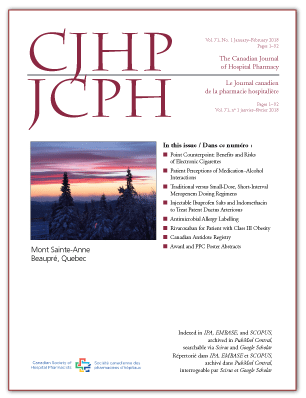Meropenem Assessment before and after Implementation of a Small-Dose, Short-Interval Standard Dosing Regimen
DOI:
https://doi.org/10.4212/cjhp.v71i1.1724Keywords:
meropenem, pharmacodynamics, stewardship, dosing, outcomes, méropénème, pharmacodynamie, gestion responsible, posologie, résultatsAbstract
ABSTRACT
Background: Small-dose, short-interval dosing for meropenem has been shown to yield pharmacokinetic and pharmacodynamic properties similar to those associated with traditional dosing of this drug. However, few studies have examined clinical outcomes in the general population.
Objectives: To characterize differences in effects between a small-dose, short-interval dosing regimen for meropenem (500 mg every 6 h) and the traditional regimen (1000 mg every 8 h) on clinical outcomes and costs to the health care system.
Methods: This retrospective cohort study included 194 patients who received the traditional meropenem dosage (July 2006 to August 2008) and 188 patients who received the small-dose, short-interval regimen (December 2008 and October 2009) at a large tertiary care hospital and a community hospital. The primary outcome (clinical success), the secondary outcomes (30-day in-hospital mortality, time to defervescence, duration of therapy, and length of stay), and drug costs were compared between cohorts.
Results: The 2 cohorts did not differ significantly in terms of baseline characteristics. There was no statistically significant difference between the small-dose, short-interval regimen and the traditional dosing regimen in terms of the primary outcome: clinical success was achieved in 83.5% (162/194) and 80.8% (152/188) of the patients, respectively. Likewise, there was no statistically significant difference in any of the secondary outcomes. The average drug cost per patient per visit was $222.23 with small-dose, short-interval dosing and $355.90 with traditional dosing, a significant difference of more than $130 per patient per visit.
Conclusion: The small-dose, short-interval meropenem dosing regimen resulted in clinical outcomes similar to those achieved with the traditional dosing regimen at significantly lower cost.
RÉSUMÉ
Contexte : Selon des études, un schéma posologique de méropénème avec administration d’une faible dose à intervalle réduit produit des résultats pharmacocinétiques et pharmacodynamiques semblables à ceux obtenus avec une posologie traditionnelle. Mais peu d’études ont examiné les résultats cliniques dans la population générale.
Objectif : Offrir un portrait des différences entre les effets d’un schema posologique de méropénème avec administration d’une faible dose à intervalle réduit (500 mg toutes les 6 heures) et d’une posologie traditionnelle (1000 mg toutes les 8 heures) pour ce qui est des résultats cliniques et des coûts pour le système de santé.
Méthodes : La présente étude de cohorte rétrospective incluait 194 patients ayant reçu le méropénème selon le schéma posologique traditionnel (entre juillet 2006 et août 2008) et 188 patients l’ayant reçu avec administration d’une faible dose à intervalle réduit (entre décembre 2008 et octobre 2009) dans un grand hôpital de soins tertiaires et un hôpital communautaire. Le principal paramètre d’évaluation (succès clinique), les paramètres d’évaluation secondaires (taux de mortalité à l’hôpital dans les 30 jours, période de défervescence, durée du traitement et durée du séjour) et les coûts des médicaments ont été comparés entre les cohortes.
Résultats : Les deux cohortes n’étaient pas significativement différentes en ce qui touche aux caractéristiques de base. Il n’y avait aucune difference statistiquement significative entre le schéma posologique avec administration d’une faible dose à intervalle réduit et la posologie traditionnelle en ce qui concerne le principal paramètre d’évaluation : le succès clinique a été obtenu respectivement chez 83,5 % (162/194) et chez 80,8 % (152/188) des patients. De même, aucune différence statistiquement significative n’a été relevée pour les paramètres d’évaluation secondaires. Par contre, le coût moyen des médicaments par patient par visite était de 222,23 $ pour le schéma posologique avec administration d’une faible dose à intervalle réduit et de 355,90 $ pour la posologie traditionnelle, une difference significative de plus de 130 $ par patient par visite (p < 0,001).
Conclusion : Le schéma posologique de méropénème avec administration d’une faible dose à intervalle réduit produisait des résultats cliniques semblables à ceux de le posologie traditionnelle, et ce, pour un prix significativement plus faible.Downloads
Published
Issue
Section
License
Copyright © Canadian Society of Healthcare-Systems Pharmacy.
After publication of a manuscript in the CJHP, the authors of the manuscript must obtain written permission from the CSHP (publications@cshp.ca) before reproducing any text, figures, tables, or illustrations from the work in future works of their own. If a submitted manuscript is declined for publication in the CJHP, all said rights shall revert to the authors. Please note that any forms (e.g., preprinted orders and patient intake forms) used by a specific hospital or other health care facility and included as illustrative material with a manuscript are exempt from this copyright transfer. The CJHP will require a letter from the hospital or health care facility granting permission to publish the document(s).










